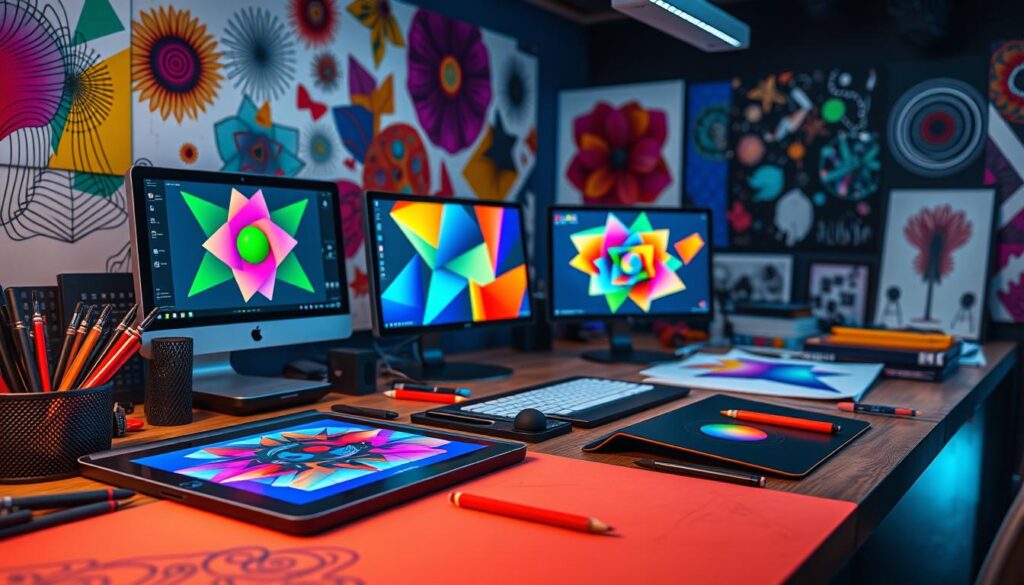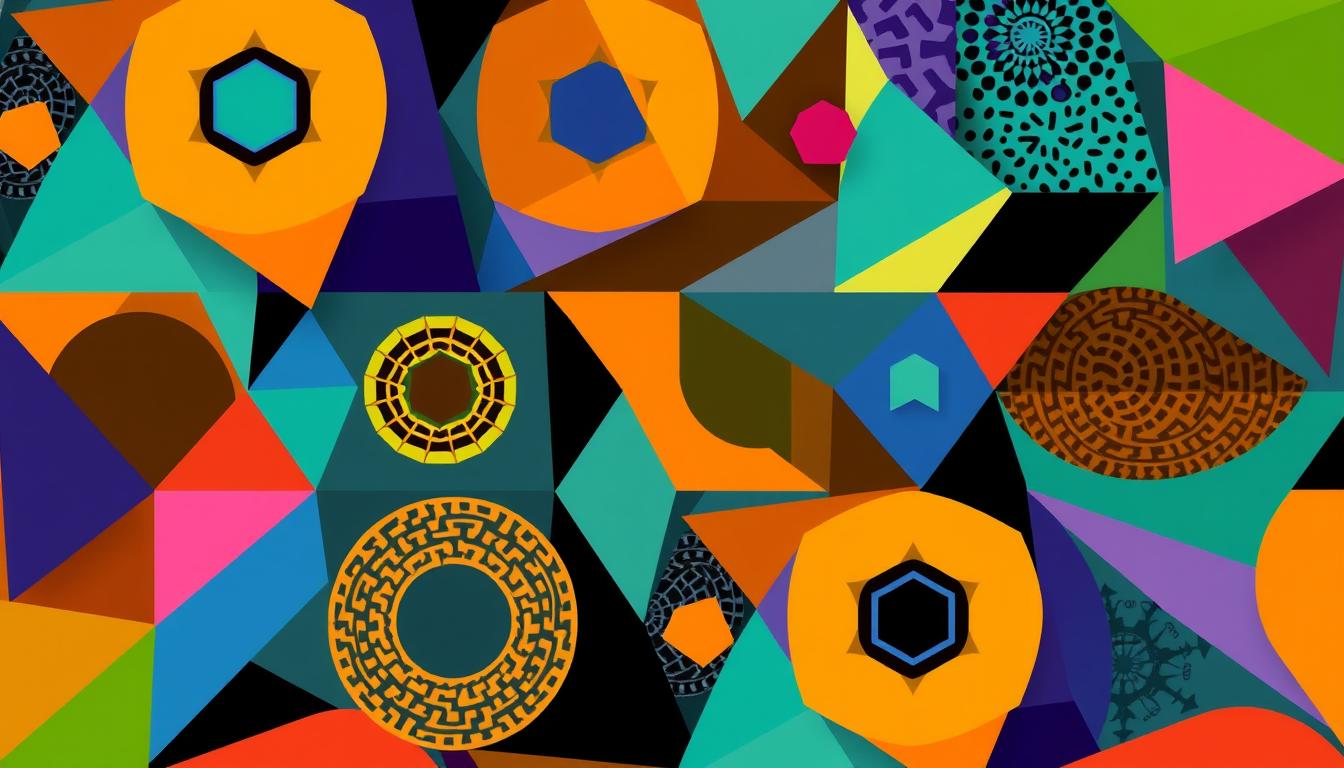In the ever-evolving world of contemporary art, geometric design has seen a resurgence. This has captivated audiences and sparked a renewed interest in shapes and patterns. As I explore this captivating realm, I’m excited to show how geometric design can be reimagined. This will create visually striking statements that leave a lasting impression.
Geometric shapes, from the simple circle to the intricate polygon, have an inherent power. They evoke emotions and transform our perception of surroundings. By using these fundamental forms, artists and designers are pushing boundaries. They infuse spaces with dynamism, balance, and visual allure.
As I delve deeper, I’ll explore the evolution of geometric design in modern art. I’ll also look at the psychological impact of shape on the viewer. And I’ll show how these timeless principles are being applied to create bold, memorable statements. Join me on this journey as we reimagine the possibilities of geometric design. Together, we’ll unlock the secrets to crafting visually stunning compositions that captivate the senses.
The Evolution of Geometric Design in Modern Art
The allure of geometric abstraction has captivated modern art for decades. Pioneers like Piet Mondrian and Kazimir Malevich laid the groundwork. Their visionary approach has influenced contemporary design movements, shaping the aesthetic landscape of the 20th and 21st centuries.
Pioneers of Geometric Abstraction
In the early 20th century, two artists revolutionized geometric abstraction. Piet Mondrian’s bold, intersecting lines and primary colors set a new standard. Kazimir Malevich’s Black Square challenged traditional representation, opening a new era in geometric abstraction in modern art.
Influence on Contemporary Design Movements
Mondrian and Malevich’s work profoundly influenced contemporary design. The Bauhaus movement’s minimalist aesthetic and the Memphis Group’s vibrant patterns reflect their impact. Their use of shape, line, and color has inspired designers and architects to create bold, visually striking compositions.
Transition from Traditional to Modern Applications
- The shift from traditional to abstract, geometric forms in modern art has been transformative. It has challenged artistic expression boundaries.
- Geometric abstraction’s rise has expanded into various disciplines. It has redefined our perception and interaction with the built environment in architecture, fashion, product design, and branding.
- This transition has opened new creative avenues. Designers and artists now experiment with shape, pattern, and color. They create innovative, visually captivating works.
Understanding the Power of Shape Psychology in Design
Designers wield the power of shape psychology to craft captivating visual stories. By grasping how geometric forms elicit emotions, we can strategically use them to enhance our designs’ impact.
At the heart of shape psychology is the idea that shapes carry inherent meanings. For example, angular shapes like triangles are often seen as dynamic and energetic. On the other hand, curved shapes like circles suggest harmony and balance. By applying these principles, we can create designs that deeply connect with our audience.
Through the application of shape psychology, we can direct the viewer’s gaze, evoke specific emotions, and tell compelling stories. Whether it’s through geometric patterns, bold shapes, or subtle forms, the potential is vast.
As we delve deeper into the connection between shape psychology, visual narratives, and design principles, we open up new ways to create lasting and impactful experiences. This is an exciting field, and I’m eager to see how designers will continue to innovate.
Geometry Reimagined: Creating Bold Statements with Shapes and Patterns
In the modern design world, geometric forms are at the forefront, expanding traditional design limits. Designers are exploring geometry’s core principles, reshaping our interaction with the environment.
Fundamental Geometric Principles
The heart of this geometric shift is understanding basic shapes. Designers delve into circles, squares, and polyhedra, studying their relationships. They aim to craft bold statements, engaging shape exploration, and stunning pattern play.
Breaking Traditional Design Rules
Innovative minds are challenging design norms, mixing geometric elements in new ways. This defiance of traditional rules is opening up a new era of design. It brings us visually striking and conceptually rich solutions.
Innovative Pattern Applications
- Geometric principles are translated into dynamic, repeating patterns for various surfaces and textiles.
- Designers explore positive and negative space to create captivating visual rhythms.
- Geometric forms are integrated into product design, branding, and installations for a lasting impact.
Designers continue to expand shape exploration and pattern play, transforming the design world. They invite us to view the familiar in fresh, captivating ways.
Architectural Integration of Geometric Patterns
Architecture and geometric design form a captivating partnership. They blend bold architectural patterns, intricate geometric facades, and innovative structural design to create stunning visual experiences. This section delves into how geometric elements are seamlessly integrated into the built environment. It highlights how architects and designers are redefining traditional architecture.
The Louvre Pyramid in Paris, designed by I.M. Pei, is a striking example of this fusion. Its sharp triangular forms stand as a testament to geometric abstraction in architecture. The structure’s clean lines and precise proportions create a mesmerizing interplay of light and shadow. This captivates visitors and passers-by alike.
The Rolex Learning Center in Lausanne, Switzerland, designed by SANAA, also showcases a remarkable integration of geometric patterns and structural design. Its undulating, fluid forms create a sense of harmony and movement. This challenges traditional notions of rigid architectural structures.
- Exploring the intersection of architectural patterns and geometric design
- Showcasing notable examples of buildings that effectively incorporate geometric facades
- Examining how structural design can be elevated through the use of geometric principles
- Discussing the impact of geometric abstraction on the perception and experience of architectural spaces
- Highlighting the role of geometric patterns in creating a sense of dynamism and innovation in modern architecture
As architects and designers continue to innovate, the integration of geometric patterns, architectural facades, and structural elements has become crucial. It enables the creation of bold, visually captivating structures. These structures inspire and captivate audiences worldwide.
Color Theory and Geometric Compositions
In the world of pattern design, grasping the essence of color theory is crucial. Designers use color harmony principles to craft geometric patterns that grab attention and stir emotions. These patterns can evoke powerful visual responses.
Color Harmony in Pattern Design
Creating harmonious color schemes is key to developing striking geometric patterns. Designers must master the use of complementary hues, analogous shades, and triadic palettes. This expertise can transform a design from mundane to mesmerizing. By achieving the right balance, designers can evoke feelings of balance, energy, or tranquility, depending on the desired mood.
Creating Depth Through Color Layering
Geometric patterns can gain depth and dimension through color layering. By layering and blending shades, designers create the illusion of depth. This adds dynamism and visual interest, making the patterns more engaging. This technique is especially useful in exploring visual perception of shapes and patterns.
Impact of Color on Geometric Perception
The selection of color theory significantly affects how we perceive geometric shapes and patterns. Warm tones can bring a sense of vibrancy and energy, while cool hues create a calming atmosphere. Designers must understand this relationship between pattern design and color to create impactful and emotionally resonant geometric compositions.
Digital Tools for Pattern Creation and Manipulation
In the ever-evolving world of design, digital tools have transformed how we create and manipulate geometric patterns. The field of digital design tools, pattern generation, and computer-aided design has expanded, offering designers new ways to express visually. This expansion has opened up a vast array of possibilities for those looking to innovate in visual expression.
Designers now have access to a wide range of digital tools, from advanced software like Adobe Illustrator and Inkscape to innovative AI platforms. These tools allow for the creation of intricate patterns, experimentation with shape variations, and the layering of colors and textures. This results in stunning visual effects.
One of the most intriguing aspects of these tools is their ability to automate pattern-making. Algorithms can generate complex, repeating designs with minimal effort. This enables designers to explore countless iterations and discover new patterns.
The capabilities of digital tools go beyond just creating patterns. Designers can also manipulate existing patterns, altering them through distortion, scaling, or layering. This level of control and flexibility allows designers to explore new dimensions in geometric design.

As we move forward, the evolution of digital design tools, pattern generation, and computer-aided design will continue to expand. The creative possibilities in geometric patterns are endless. The future promises to bring endless opportunities for designers to use technology to express their artistic vision. This will change how we perceive and interact with our surroundings.
Incorporating Cultural Influences in Geometric Design
In the ever-evolving world of design, the integration of cultural patterns and heritage-inspired geometry has become a captivating trend. Designers today are skillfully blending global influences to create striking visual narratives that resonate with audiences across borders.
Global Pattern Heritage
From the intricate Islamic geometric patterns of the Middle East to the bold, Maori-inspired motifs of New Zealand, the world is brimming with a rich tapestry of traditional design elements. Designers are now exploring these cultural patterns, reinterpreting them through a modern lens to infuse their work with a global design influence.
Modern Cultural Fusion
- Designers are seamlessly merging ancient cultural symbols with sleek, contemporary aesthetics.
- The result is a harmonious blend of heritage-inspired geometry and cutting-edge design sensibilities.
- This approach not only pays homage to the past but also speaks to the diverse, interconnected nature of today’s global community.
By harnessing the power of cultural patterns and global design influence, designers are creating bold, captivating visuals that resonate on a deeper level. This fusion of the traditional and the modern is a testament to the enduring influence of cultural heritage in the ever-evolving landscape of design.
Sustainable Approaches to Pattern Design
The world of geometric design is transforming to meet the growing demand for sustainable and eco-friendly products. Designers are now integrating sustainable design, eco-friendly patterns, and green geometry into their work. This evolution is crucial for the future of pattern design.
Material selection is a key aspect of sustainable pattern design. Designers are choosing natural, biodegradable, and recycled materials. These include organic cotton and bamboo fibers, which are becoming staples in creating striking geometric patterns.
The production methods in pattern design are also changing. Techniques like water-based printing and zero-waste processes are being adopted. These methods reduce the industry’s carbon footprint. They align with the increasing consumer demand for ethical and responsible design.
Designers are adopting a more holistic approach to their work. They consider the entire lifecycle of a pattern. This includes creating patterns that can be easily disassembled, repurposed, or recycled. This approach minimizes waste and supports a circular economy.
By focusing on sustainable design, eco-friendly patterns, and green geometry, designers are leading the way. They are creating a future where bold, geometric designs and environmental consciousness can thrive together. This shift not only benefits the planet but also opens up new creative avenues in pattern design.
Commercial Applications of Geometric Patterns
Geometric design’s allure continues to grow, influencing various commercial fields. It makes bold statements in retail and blends seamlessly into brand identities and marketing. This design’s impact is clear and powerful.
Retail Space Design
Geometric patterns are revolutionizing retail design. They introduce bold, eye-catching elements that grab customers’ attention. Retailers use dramatic floor patterns and geometric motifs on walls to enhance the shopping experience.
These designs leave a lasting impression on visitors. They make the in-store experience memorable and impactful.
Brand Identity Integration
Geometric patterns are key for brands wanting a modern, unique identity. They incorporate geometric elements into logos, packaging, and branding. This shows innovation, dynamism, and visual appeal.
It strengthens brand recognition and sets businesses apart. In a crowded market, geometric design helps brands stand out.
Marketing Material Development
Geometric patterns are versatile in marketing materials, acting as a visual language. They make social media graphics and print collateral stand out. The use of geometric shapes and compositions boosts the aesthetic.
This approach makes marketing campaigns more memorable. It appeals to those who seek bold, modern, and visually appealing content.



